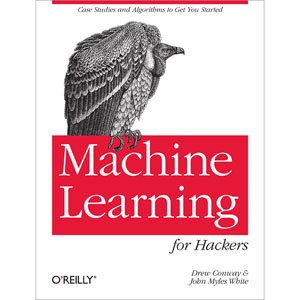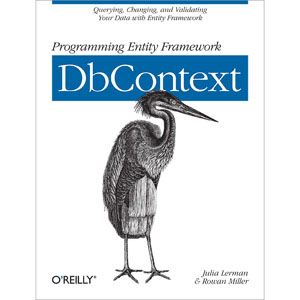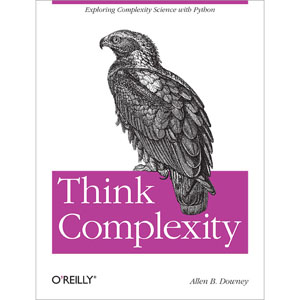| Machine Learning for Hackers Posted: 12 Mar 2012 08:57 AM PDT 
Book Description If you're an experienced programmer interested in crunching data, this book will get you started with machine learning—a toolkit of algorithms that enables computers to train themselves to automate useful tasks. Authors Drew Conway and John Myles White help you understand machine learning and statistics tools through a series of hands-on case studies, instead of a traditional math-heavy presentation. Each chapter focuses on a specific problem in machine learning, such as classification, prediction, optimization, and recommendation. Using the R programming language, you'll learn how to analyze sample datasets and write simple machine learning algorithms. Machine Learning for Hackers is ideal for programmers from any background, including business, government, and academic research. - Develop a naïve Bayesian classifier to determine if an email is spam, based only on its text
- Use linear regression to predict the number of page views for the top 1,000 websites
- Learn optimization techniques by attempting to break a simple letter cipher
- Compare and contrast U.S. Senators statistically, based on their voting records
- Build a "whom to follow" recommendation system from Twitter data
Table of Contents
Chapter 1. Using R
Chapter 2. Data Exploration
Chapter 3. Classification: Spam Filtering
Chapter 4. Ranking: Priority Inbox
Chapter 5. Regression: Predicting Page Views
Chapter 6. Regularization: Text Regression
Chapter 7. Optimization: Breaking Codes
Chapter 8. PCA: Building a Market Index
Chapter 9. MDS: Visually Exploring US Senator Similarity
Chapter 10. kNN: Recommendation Systems
Chapter 11. Analyzing Social Graphs
Chapter 12. Model Comparison Book Details - Paperback: 322 pages
- Publisher: O’Reilly Media (February 2012)
- Language: English
- ISBN-10: 1449303714
- ISBN-13: 978-1449303716
Note: There is a file embedded within this post, please visit this post to download the file. Related Posts 

|
| Programming Entity Framework: DbContext Posted: 12 Mar 2012 08:53 AM PDT 
Book Description The DbContext API captures Entity Framework's (EF) most commonly used features and tasks, simplifying development with EF. This concise book shows you how to use the API to perform set operations with the DbSet class, handle change tracking and resolve concurrency conflicts with the Change Tracker API, and validate changes to your data with the Validation API. With DbContext, you'll be able to query and update data, whether you're working with individual objects or graphs of objects and their related data. You'll find numerous C# code samples to help you get started. All you need is experience with Visual Studio and database management basics. - Use EF's query capabilities to retrieve data, and use LINQ to sort and filter data
- Learn how to add new data, and change and delete existing data
- Use the Change Tracker API to access information EF keeps about the state of entity instances
- Control change tracking information of entities in disconnected scenarios, including NTier applications
- Validate data changes before they're sent to the database, and set up validation rules
- Bypass EF's query pipeline and interact directly with the database
Table of Contents
Chapter 1. Introducing the DbContext API
Chapter 2. Querying with DbContext
Chapter 3. Adding, Changing, and Deleting Entities
Chapter 4. Working with Disconnected Entities Including N-Tier Applications
Chapter 5. Change Tracker API
Chapter 6. Validating with the Validation API
Chapter 7. Customizing Validations
Chapter 8. Using DbContext in Advanced Scenarios
Chapter 9. What's Coming Next for Entity Framework Book Details - Paperback: 256 pages
- Publisher: O’Reilly Media (January 2012)
- Language: English
- ISBN-10: 1449312969
- ISBN-13: 978-1449312961
Note: There is a file embedded within this post, please visit this post to download the file. Related Posts 

|
| Think Complexity Posted: 12 Mar 2012 08:48 AM PDT 
Book Description Expand your Python skills by working with data structures and algorithms in a refreshing context—through an eye-opening exploration of complexity science. Whether you're an intermediate-level Python programmer or a student of computational modeling, you'll delve into examples of complex systems through a series of exercises, case studies, and easy-to-understand explanations. You'll work with graphs, algorithm analysis, scale-free networks, and cellular automata, using advanced features that make Python such a powerful language. Ideal as a text for courses on Python programming and algorithms, Think Complexity will also help self-learners gain valuable experience with topics and ideas they might not encounter otherwise. - Work with NumPy arrays and SciPy methods, basic signal processing and Fast Fourier Transform, and hash tables
- Study abstract models of complex physical systems, including power laws, fractals and pink noise, and Turing machines
- Get starter code and solutions to help you re-implement and extend original experiments in complexity
- Explore the philosophy of science, including the nature of scientific laws, theory choice, realism and instrumentalism, and other topics
- Examine case studies of complex systems submitted by students and readers
Table of Contents
Chapter 1. Complexity Science
Chapter 2. Graphs
Chapter 3. Analysis of Algorithms
Chapter 4. Small World Graphs
Chapter 5. Scale-Free Networks
Chapter 6. Cellular Automata
Chapter 7. Game of Life
Chapter 8. Fractals
Chapter 9. Self-Organized Criticality
Chapter 10. Agent-Based Models
Chapter 11. Case Study: Sugarscape
Chapter 12. Case Study: Ant Trails
Chapter 13. Case Study: Directed Graphs and Knots
Chapter 14. Case Study: The Volunteer's Dilemma Appendix. Call for Submissions
Appendix. Reading List Book Details - Paperback: 158 pages
- Publisher: O’Reilly Media (January 2012)
- Language: English
- ISBN-10: 1449314635
- ISBN-13: 978-1449314637
Note: There is a file embedded within this post, please visit this post to download the file. Related Posts 

|





Tidak ada komentar:
Posting Komentar